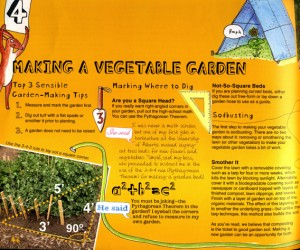
by Leslie Savage
No Guff Vegetable Gardening
Donna Balzer and Steven Biggs
No Guff Press, 2011
Seed packets bedeck the stands this week at Home Hardware, a reminder that spring is here. There will be life after skiing, and if you need further inspiration than what a seed packet provides, here’s a new approach to a book on vegetable gardens.
No Guff Vegetable Gardening is written by two experienced home veggie-patch gardeners, Donna Balzer of Calgary and Steven Biggs of Toronto. The look of the book, and its marvelous layout and illustrations, are by Bryan and Mariko McCrae of Feedlot Studios on Gabriola Island. The book is like no gardening book you’ve ever seen.

First, it’s fun to look at. Two, it doesn’t pretend to give definitive answers. The book is essentially a conversation between Donna and Steven, two urban gardeners in different parts of the country. They don’t always agree. It’s like a kitchen table conversation with a couple of experienced gardeners. They argue about almost everything: Donna likes rotating composters, Steve thinks they’re silly. Donna uses root stimulants when transplanting, Steve doesn’t. Steve thinks the important thing about watering young seedlings is not to douse them too powerfully; Donna focuses on the quality of the water and its temperature — and Steven says “You mean you don’t have a water-warming gadget?” It’s an engaging way to present information, and often hilarious.
No Guff Vegetable Gardening is a debunking operation, always a great strategy when writing a book for a wide audience on topics that invite controversy. Donna and Steve create Ernie McGuff, drawn cleverly by Mariko McCrae as a jowl-faced heavy who thinks he has the answer to everything. Donna and Steve debunk lots of so-called gardening wisdom. Guff says: Double and triple dig your veggie patch. Donna and Steve both question this, saying that too much turning can put too much oxygen into the soil, which speeds the decomposition of organic matter, when what you want is slow decay so that plants will be fed for a longer period.
There is so much information in the book that it’s best to read it slowly, chapter by chapter, and preferably — as I will do once the

snow melts — as you create your own garden this spring. It’s a relief to learn that even in Calgary it’s tough to grow tomatoes without a frame, and that eggplant success is unlikely. On the other hand, Donna and Steven both give thumbs up to trial and error, saying that mini-climates and your own gardening space may defy official ‘Zones’ and ‘Garden Knowledge.’ Their approach to growing vegetables is that a) it should be fun and if you don’t enjoy it what’s the point? b) that it’s very personal—what works for one person is “right” no matter what the books say; and c) that you shouldn’t have to spend a lot of money conforming to printed advice. They’ve made their book informal and conversational to encourage dialogue about gardening, and they back this up with websites: www.donnabalzer.blogspot.com (Donna) and www.the-locavores-garden.com/ (Steven).
This is as much a book to look at as to read. Every page has photos, illustrations, tables, and handwritten tips — it’s a visual feast, and the photos of the veggies at the back of the book are truly inspiring. The instructions and illustrations about turning lawn into a vegetable garden — smother the grass first, or roll it back as sod — are of particular interest to me, as this is what I plan to do with my side yard.
One particular point of appeal to the No Guff approach concerns bugs (my personal nemesis): Donna and Steven don’t like pesticides, not even soap, and prefer to attract good bugs to the garden, put up with a few holes in the lettuce, pick off things that do come by, and use newspaper collars around tomato plants. This seems really important in Revelstoke, where anything you put on the ground will soak through the sandy river cliff soil into the water system that feeds the river and ends up in the ocean. (If I’m geomorphically wrong about this, I hope someone will correct me.)
No Guff Vegetable Gardening is available at Grizzly Books.



